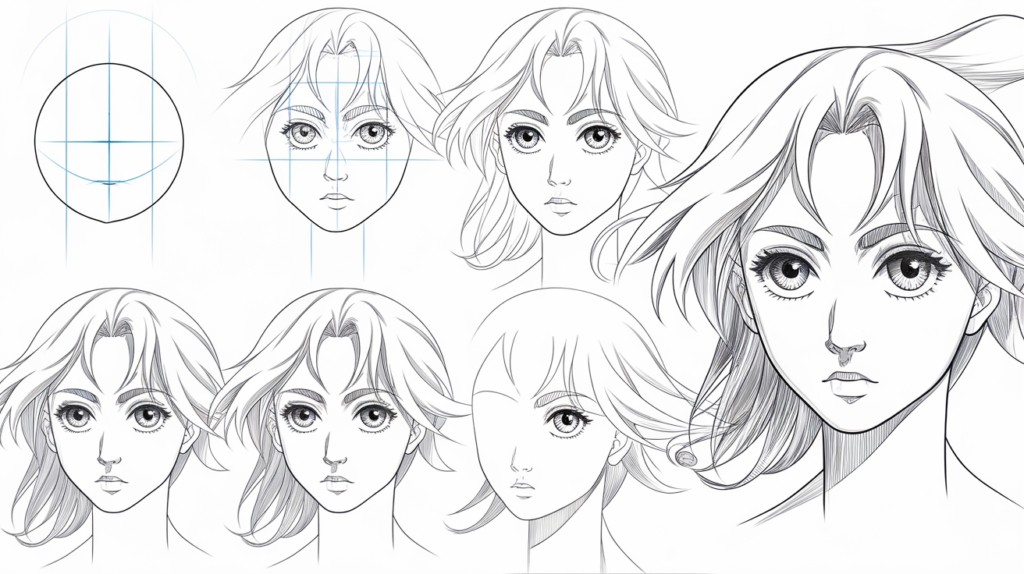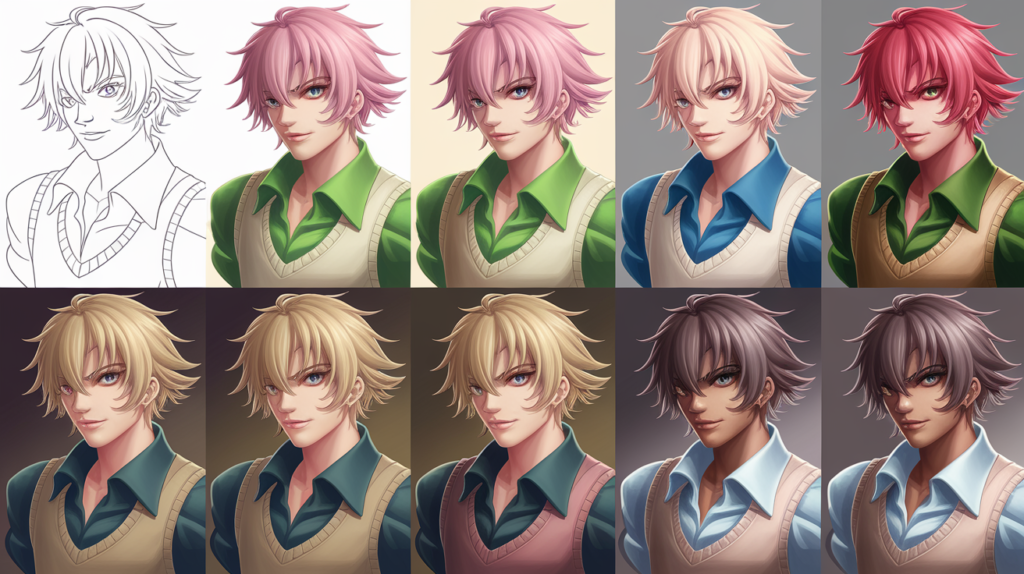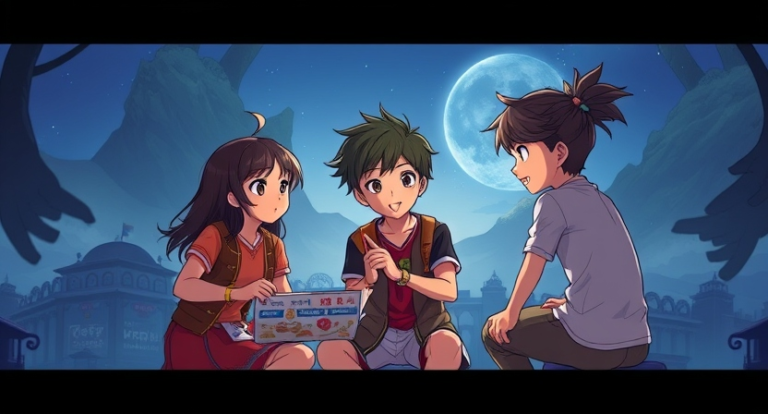Introduction

Whether you’re a fan of anime series or just love the art form, learning how to draw anime for beginners can be an exciting creative journey. Anime is one of the most popular art styles in the world, known for its distinctive characters, expressive faces, and dynamic poses. In this guide, I’ll walk you through five essential steps that will help you start drawing your very own anime characters, even if you’re an absolute beginner. Ready to dive in? Let’s get started!
Essential Drawing Materials for Anime
You don’t need a lot of fancy equipment to start anime. Here’s what you’ll need:
- Pencils: Start with a simple set of pencils, preferably with different hardness levels (like HB, 2B).
- Paper: Sketching paper works best, but you can even use a regular notebook when starting out.
- Digital Tools: If you prefer digital drawing, a tablet like a Wacom or iPad paired with drawing software is perfect.
- Erasers: A kneaded eraser works great for cleaning up lines.
- Inking Pens: Fine-tipped pens are essential if you want to go over your pencil sketches with clean, crisp lines.
- Optional: Colored pencils or markers for shading and coloring.
Now that you’re equipped, let’s move on to the drawing process!
Step 1: Drawing the Head and Face
Most anime characters begin with the head, which is often larger in proportion compared to the body, especially for younger characters or those in “chibi” style.

Drawing Anime Eyes
Eyes are one of the most iconic features of anime. Begin by drawing large oval shapes on either side of the vertical line. Make sure the eyes are big, expressive, and symmetrical. Add the iris and pupil, keeping them large, and draw highlights to give them a shiny, lively look.
Sketching the Nose and Mouth
Anime noses are usually small and subtle, often just a simple dot or short line. The mouth should be placed below the nose, drawn with a light curve. Make sure the mouth’s expression matches the mood you want to convey, from happy to serious.
Adding the Ears and Hairline
Ears are drawn slightly above the horizontal line for the eyes and are usually simple curves. For the hairline, draw a light guideline across the forehead and start sketching the basic shape of the character’s hair, which is often spiky, flowing, or very stylized in anime.
Step 2: Drawing the Body
Once the head is done, it’s time to move on to the body. Anime bodies are often simplified and more stylized than realistic figures.

Basic Proportions
Anime characters tend to have slender bodies. A good starting point is to make the body about six to seven heads tall. Sketch out the torso, shoulders, and hips lightly to maintain proper proportions.
Differences in Male and Female Bodies
Male characters are typically drawn with broader shoulders and more angular features, while female characters are often curvier and have smaller waists.
Drawing Arms and Hands
Arms can be tricky, but a good rule of thumb is to make the hands end about mid-thigh when the arms are relaxed. Practice sketching hands in different positions to get a feel for how they move.
Drawing Legs and Feet
Legs should be long and slender, tapering off at the ankles. When drawing feet, start with a simple triangle shape and refine the details as you go.
Step 3: Outlining and Refining Your Sketch
Once you’ve got your basic sketch down, it’s time to refine it. Go over your lines with a darker pencil or an inking pen. Pay attention to line thickness using thicker lines for outer contours and thinner lines for inner details can add depth to your drawing.

Step 4: Adding Details
Clothing and Accessories
Adding clothing can be fun and allows you to explore your character’s personality. Whether it’s a school uniform or a suit of armor, make sure the clothing follows the body’s natural curves.

Hairstyles
Anime characters are known for their wild, colorful hair. Use light, curved lines to sketch the basic shape of the hair, and then layer strands to add volume and texture.
Capturing Movement and Emotion
Anime is all about expression. Add small details like wrinkles in clothing or exaggerated facial features to show emotions like excitement, anger, or sadness.
Step 5: Shading and Coloring
Understanding Light and Shadow
Shading can bring your anime character to life by giving it depth. Decide on a light source, and then add shadows to areas that are hidden from the light, like under the chin, below the hair, and behind the arms.

Traditional Coloring vs. Digital Coloring
If you’re working traditionally, colored pencils or markers are a good choice. Digital artists can experiment with layers, blend modes, and brushes for smooth, vibrant colors.
Common Mistakes to Avoid
One common mistake beginners make is focusing too much on small details before getting the proportions right. Another mistake is drawing too many lines, making the drawing look cluttered. Keep it simple, and always work from general shapes to more detailed features.
Practice Makes Perfect: How to Improve Your Skills
The more you draw, the better you’ll get. Practice different characters, poses, and expressions. Study your favorite anime and see how professional artists approach certain scenes. Most importantly, don’t be afraid to make mistakes each one is a step toward improvement!
Conclusion

Drawing anime can be a lot of fun, but like any skill, it takes practice and patience. Start simple, follow these steps, and soon enough, you’ll see your skills improve. Remember, the key to getting better is consistency and creativity. So grab your pencil, find some inspiration, and start drawing your own anime world today!
FAQs On How to Draw Anime for Beginners
How long does it take to learn to draw anime?
It depends on your practice frequency, but most beginners see noticeable improvements within a few months.
Can I draw anime without knowing how to draw realistically?
Yes, while it helps to understand basic anatomy, anime is a stylized form of art, so you can start learning even without realistic drawing skills.
What software is best for drawing anime digitally?
Clip Studio Paint and Procreate are popular choices for digital anime drawing.
Should I trace anime images to learn?
While tracing can help you understand shapes and lines, it’s better to practice freehand drawing to develop your skills.
How do I draw different anime emotions?
Focus on the eyes and mouth—these are the most expressive parts in anime characters. Experiment with exaggeration for dramatic emotions.








Very helpful